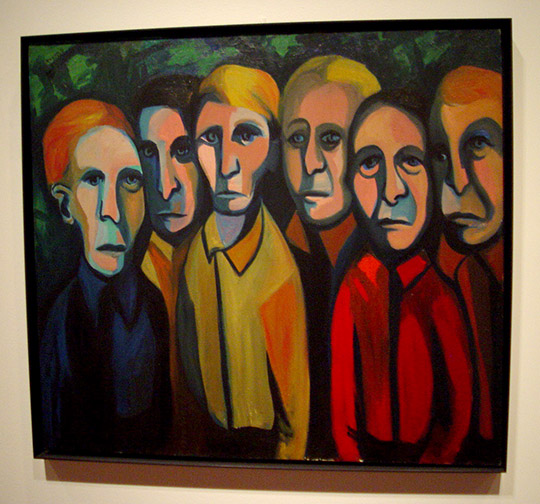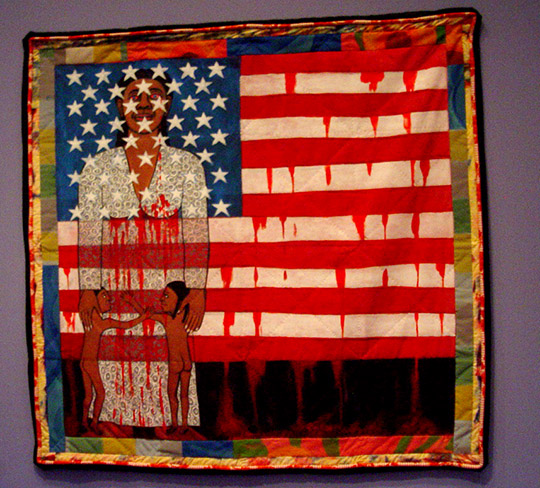Earlier this year, the 91-year-old American artist Faith Ringgold was given her first comprehensive show in her hometown of New York City at the New Museum in the Bowery.
The exhibit has traveled to the de Young Museum in San Francisco's Golden Gate Park, and it's stunning. Pictured above is Ringgold's 1965 Self-Portrait.
Born in 1930 to what seems to have been a loving, culturally sophisticated family in Harlem, Faith was the youngest of three sisters and asthmatic, which meant she spent a lot of time indoors making art with crayons under the eye of her fashion designer mother. She made her first impact on the New York art scene in the 1960s with the highly political American People Series. Pictured above is the 1963 American People Series #2: For Members Only a memory piece of what she saw staring at her when her Harlem Sunday school took a field trip to Tibbetts Brook Park in Yonkers, New York, and a gang of white men with sticks demanded they return home.
A lot of political art doesn't age well, but Ringgold's certainly has. The 1967 American People Series #18: The Flag Is Bleeding, now looks and feels iconic.
According to a Wikipedia account, "In 1968, fellow artist Poppy Johnson and art critic Lucy Lippard founded the Ad Hoc Women's Art Committee with Ringgold and protested a major modernist art exhibition at the Whitney Museum of American Art. Members of the committee demanded that women artists account for fifty percent of the exhibitors and created disturbances at the museum by singing, blowing whistles, chanting about their exclusion, and leaving raw eggs and sanitary napkins on the ground. Not only were women artists excluded from this show, but no African-American artists were represented either." Pictured above from that period is her 1969 Black Light Series #12: Party Time.
In 1972, she partnered with her seamstress/designer mother, Willi Posey, on feminist, Nepali-style tankas where a painting is framed by fabric, for pieces in the Slave Rape Series. The trio above are entitled #1: Fear Will Make You Weak, #2: Run You Might Get Away, and #3: Fight to Save Your Life.
In the 1980s, after not being able to find a publisher for a memoir she had written, she began to create painted quilts with written stories surrounding the perimeter left and right. Above is a 1987 story-quilt beginning in the 1920s of seduction, family secrets, and love, called Bitter Nest. Sadly, these story-quilts are separated and in different collections around the country, so this exhibit's Bitter Nest only has three parts out of the five. Thank goodness for the internet where it's possible to piece the story installments together, and discover that the drama has a happy ending.
The same might be said of Ringgold herself. She married a jazz pianist in 1950, gave birth to two daughters, and separated from her husband on account of his heroin addiction. She remarried auto assembler Burnett Ringgold in 1962 with whom she lived happily for over 50 years. Ringgold not only had her memoir eventually published, but her first children's book in 1991, Tar Beach, was an instant, bestselling classic. From 1987 to 2002 she also taught at UC San Diego. Pictured above is A Family Portrait: The American Collection #2, 1997.
In 1997 Ringgold revisited her own work with The Flag Is Bleeding #2: The American Collection, where gender and race have changed from the original.
It is only in the last few years that Ringgold has finally been receiving the institutional acclaim that her work deserves. Pictured above is the 1997 Born in a Cotton Field: The American Collection #3.
Be sure to check out this long overdue exhibit of an artist most people, including myself, have never heard of before. The exhibit will be at the de Young through November 27. Pictured above are the 2010 Jones Road Part II fabric paintings: Harriet Tubman Tanka #1: Escape to Freedom, Sojourner Truth Tanka #2: Ain't I a Woman?, and Martin Luther King Jr. Tanka #3: I Have a Dream.
The Faith Ringgold exhibit is not particularly crowded and there are no extra fee add-ons to general admission to the museum, which means you can see it for free on Saturdays if you are a Bay Area resident. Where it is crowded is the traveling Egyptian blockbuster exhibition, Ramses the Great and the Gold of the Pharaohs. Pictured is the Upper Part of a Colossus of Ramses II.
There are cedar coffins and animal mummies and jewelry and statuary glorifying the most powerful and long-lived of the ancient pharoahs, Ramses II. Unfortunately, all of his treasures and personal effects were stolen over the centuries by graverobbers, so the exhibit is sort of a marketing cheat.
The $40 admission fee gets you into a group that watches a widescreen history video together, and then you can wander freely among small, tight, claustrophobic spaces with too many people trying to squeeze amongst each other to take photos. Pictured above is a Statue of Khaemwaset, holding a figure of Ptah.















No comments:
Post a Comment